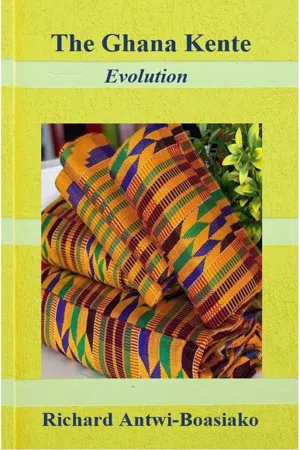
- English
- ePUB (mobile friendly)
- Available on iOS & Android
eBook - ePub
The Ghana Kente Evolution
About this book
The evolution of the Ghana Bonwire Kente cloth. The meanings of the cloth names, the design names, and the colors used in Kente cloth weaving. The evolution of the Kente cloth from being a Royal cloth to being a cloth for all and for all occasions. The traditional and contemporary views on the Ghana Bonwire Kente cloth.
Frequently asked questions
Yes, you can cancel anytime from the Subscription tab in your account settings on the Perlego website. Your subscription will stay active until the end of your current billing period. Learn how to cancel your subscription.
At the moment all of our mobile-responsive ePub books are available to download via the app. Most of our PDFs are also available to download and we're working on making the final remaining ones downloadable now. Learn more here.
Perlego offers two plans: Essential and Complete
- Essential is ideal for learners and professionals who enjoy exploring a wide range of subjects. Access the Essential Library with 800,000+ trusted titles and best-sellers across business, personal growth, and the humanities. Includes unlimited reading time and Standard Read Aloud voice.
- Complete: Perfect for advanced learners and researchers needing full, unrestricted access. Unlock 1.4M+ books across hundreds of subjects, including academic and specialized titles. The Complete Plan also includes advanced features like Premium Read Aloud and Research Assistant.
We are an online textbook subscription service, where you can get access to an entire online library for less than the price of a single book per month. With over 1 million books across 1000+ topics, we’ve got you covered! Learn more here.
Look out for the read-aloud symbol on your next book to see if you can listen to it. The read-aloud tool reads text aloud for you, highlighting the text as it is being read. You can pause it, speed it up and slow it down. Learn more here.
Yes! You can use the Perlego app on both iOS or Android devices to read anytime, anywhere — even offline. Perfect for commutes or when you’re on the go.
Please note we cannot support devices running on iOS 13 and Android 7 or earlier. Learn more about using the app.
Please note we cannot support devices running on iOS 13 and Android 7 or earlier. Learn more about using the app.
Yes, you can access The Ghana Kente Evolution by Richard Antwi-Boasiako in PDF and/or ePUB format, as well as other popular books in Art & American Art. We have over one million books available in our catalogue for you to explore.
Information

Chapter 1

Kente Cloth History
The origin of the name Kente is contested by two main tribes in Ghana namely the Asantes from Ashanti region in Ghana and the Ewes from the Volta region in Ghana. The Asantes claim Kente is derived from the Akan word “Kenteng” (which means basket) because the weaving and the final product looks like a basket. Another name the Asantes used for Kente is Kenteng Ntoma (meaning basket cloth). The Ewes claim Kente is from the Ewe word “Kete” which had been corrupted into Kente. In the Ewe language "ke" means to open and "te" means to tighten. Both tribes have incredibly beautiful Kente cloth. There are differences between Asante and Ewe Kente cloth. The Asante Kente has both sides of the cloth having the main design and looking identical. It is therefore difficult to differentiate the two sides. The Ewe Kente however has only one side showing the main design. This book is not meant to resolve the question of the origin of Kente but rather give you an insight into the Asante Bonwire Kente.
Asante history is mainly oral tradition and legend has it that two hunters Opoku Kurago and Kwakye Ameyaw from Asante Bonwire went hunting and observed a spider spinning a web. They studied this art of weaving by the spider which they mimicked in the weaving of Kente. The place where the spider was seen is now a historic site near Bonwire called Ayewakeseho. Kente weaving started around 1679 in Asante Bonwire. The first Kente cloth was black and white with thread from the raffia tree (Edowa). It was a bit uncomfortable on the skin, so the weavers decided to experiment with other materials. They found out that a local tree called Onyina (false-kapok tree) had pods full of a silky cotton-like substance that surrounds the seed. This was used to create the threads for the Kente cloth. With the expansion of the Asante kingdom through wars, places where actual cotton grew became part of the Asante empire and cotton became the preferred raw material for the threads.

Kente Loom (Nsadua)
The evolution of Kente cloth can be grouped into three main phases. The first phase had quite a simple weaving system and the output was called Ayaase Nwin-Ntoma (waist woven cloth). With this system the weaver tied the threads around the two big toes of both legs and then tied it around the waist to form a triangular shape. Raffia fiber known locally as edowa was the main yarn. This was an important invention at that time, but raffia fibers were extremely uncomfortable on the skin.
The second phase also using the Raffia fibers produced what was called Asaase-Nwin-Ntoma (ground woven cloth). With this system, which was a big improvement of the first one, the weaver constructed three pegs on the ground in a triangular shape and tied the threads around them. This made the weaving easier and faster than the ones around the waist.
The third phase which is still in use produced what is called Nsaduaso-Nwin-Ntoma (loom woven cloth). This is the system of weaving the cloth in a loom. This system has seen extraordinarily little change. It is an amazingly simple but effective way of creating the Kente strips which are later joined to form the larger piece. The first cloth from the loom was called Gagamuga.
In the beginning, Kente cloth was woven only in black and white. When the European traders came to Ghana (then Gold Coast), Oyoko women traders were introduced to different fabric colors by these European traders and this revolutionized Kente weaving. These Oyoko women traders returned to Bonwire with colored head scarfs they bought from the Europeans. The black and white cloth evolved into the rich colorful cloth we have today. The introduction of color is credited to Nana Otaa Kraban the brother-in-law of Opoku Kurago and Kwakye Ameyaw. He was able to create different colors from the bark of trees. The bark of the tree was boiled with the white threads to turn them into rich colorful threads used in Kente weaving. The primary Kente colors were yellow, black, red, and green. The early Kente cloths after Nana Otaa Kraban’s invention were colorful but had no designs until Nana Osei Kuffour came up with a way to weave geometric designs which is now part of every beautiful Kente.
Kente is mainly made from silk, rayon, and cotton. Silk is a slippery material and difficult to wear. Most Kente weavers prefer rayon and cotton. Each geometric design and color have a specific meaning. The people from Bonwire taught other people in the areas they migrated how to weave Kente. The weaving of Kente therefore became widespread throughout Ghana especially the towns around Bonwire. However only few master weavers in Bonwire have the expertise to weave certain complex designs such as Asasia and Nkontompo Kente.
Another local name for the Kente Cloth is nwin-ntoma (meaning woven cloth). Every Kente starts as a long strip (about 4 inches wide and 6 feet long). These strips are later joined by hand or machine to create a larger piece. The men cloth normally uses 28 of these strips and the women need about 24 strips. Both the colors and the designs have special significance and meaning to the Asante people.
There are three main types of weaving Kente, namely Single, Double and Triple weave. A single weave Kente has no designs in it. It takes the least amount of time and is the cheapest. The local name is Ahwrepan. A double weave Kente has some designs in each block. This is the most popular as it is affordable to most people. The local name is Topreko. A triple weave Kente is the most time-consuming type. Each block is completely made up of designs. The local name is Topreno. Another name for a triple weave is Edwin Si Edwin So meaning design after design. It is as expected, the most expensive. A triple weave Kente cloth used to be called Wabo bra meaning you have made it in life.
There are the traditional Kente designs and the contemporary designs. The Kente weaver sits in a Kente loom and uses both hands and feet to control the weaving. The intended design for the cloth determines the colors of thread and symbols used. The repeated design normally determines the name of the cloth. Different cloths may have some designs that are the same but the patterns in which the designs are used eventually determines the name of the cloth. The weaver usually names the Kente cloth. Recently though, some Kente cloths have been renamed to commemorate an occasion or when a prominent person uses it. Names like Obama Kente and Fathia Fata Nkrumah are rebranding for existing Kente cloths.
All stools (Chieftaincy) in the Asante Kingdom are created by the Kings of Asante. There are several stools created in connection with Kente weaving. Stools in connection with Kente are placed under the Gyaase division of the Asante Kings court. There are currently Kentehene (Kente Chief), Yokomaahene (Chief of the color Kente), Awinfohene (Kente Design Chief), and Fufutomahene (White dominated Kente Chief).
Traditionally, custom demands that all the Asantehene’s Kente be made only at Bonwire through the Kente Chiefs. The designed Asantehene Kente cloths were not permitted to be woven for any other person even if one could afford it. With time this tradition is g...
Table of contents
- Title Page
- Copyright Page
- Preface
- Chapter 1
- Kente Cloth History
- Chapter 2
- Kente Cloth Loom
- Chapter 3
- Kente Cloth Colors
- Chapter 4
- Kente Cloth Patterns
- Chapter 5
- Kente Cloth Names - Traditional
- Chapter 6
- Kente Cloth Names - Contemporary
- Chapter 7
- Kente Cloth – Adinkra Symbols
- Chapter 8
- Kente Cloth - Other Uses
- Chapter 9
- Kente Cloth and Foreigners
- Chapter 10
- Kente Cloth Weaving – Future


